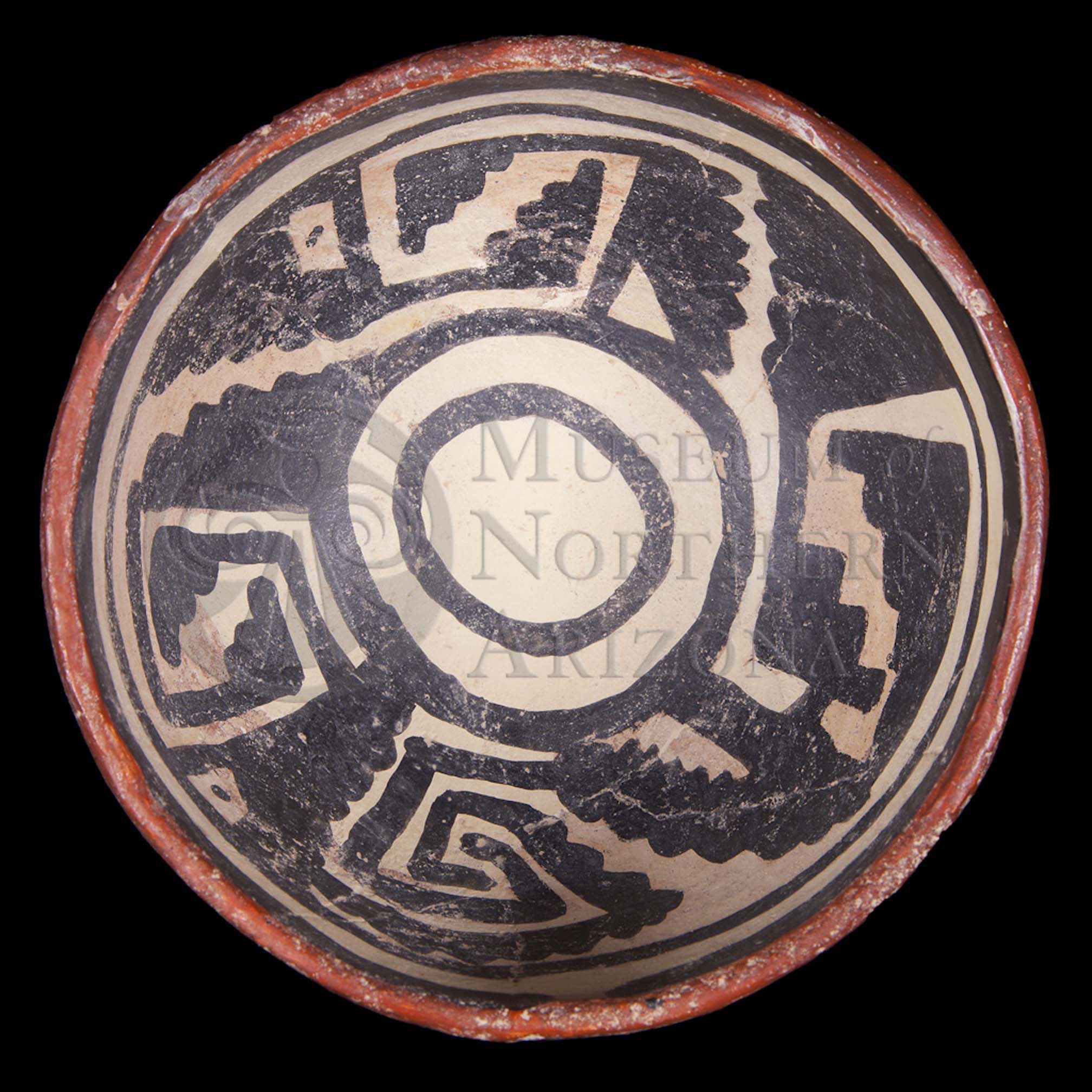
Gila Polychrome bowl from the Museum of Northern Arizona collections. Click the image to open the Gila Polychrome gallery.
Gila Polychrome was one of the most widespread of the Roosevelt Red Wares. Found almost everywhere south of the Mogollon Rim and in concentrations in the Roosevelt Basin, Tonto Basin, Gila Basin, Verde Valley, San Pedro Valley, and around Globe and Stafford, Arizona, this type as also been found occasionally near Winslow, Ajo, Gila Bend, and Nogales, Arizona; El Paso Texas and Casas Grandes, Mexico.
Archaeological Culture: Salado
Date Range: A.D. 1300-1450.
Construction: By coiling.
Firing: In an oxidizing atmosphere.
Core Color: Brick-red, tan, gray to black.
Carbon Streak: Common.
Temper: Moderately abundant fine water-worn sand.
Surface Finish:
- Bowl interiors: Well-smoothed and coated all over with thick slip; usually crazed; slightly gritty; never polished.
- Bowl exteriors: coated with thin slip; usually well-polished, horizontal striations; occasionally also coated from rim downward about halfway to base with the same slip as used on interiors.
- Jar exteriors: well smoothed; coated with the same slip as used on bowl interiors from (but not including rim to point about midway between base and greatest body diameter; unpolished; usually gritty; crazed; inside necks and area below (white) slip, coated with thin (red) wash; well-polished.
Surface Color: Bowl exteriors, red, sometimes white in part; bowl interiors, creamy white; jar exteriors, red and white; bases and other areas from which wash has weathered, color dull brownish to brick-red.
Forms: Bowls, jars, figurines.
Vessel Thickness: 4 to 7.4 mm; average, 6 mm (jars).
Decoration:
- Paint: Black, dense, carefully applied.
- Pigments: Carbon.
- Design: Bowl interiors usually completely covered in all over layout, frequently with fold design or horizontal band leaving open circle in bottom; decoration never carried to the rim; rim usually plain, occasionally ticked; bowl exteriors usually unpainted; on bowls having exterior white slip appears decorative band similar to band on interiors, with horizontal stripe just below rim, stripe almost always broken; jar decoration has horizontal stripe, usually broken, encircles shoulder, dividing white slipped area into two zones, one around the neck and one around the body; zones painted in bands containing elements similar to elements on bowl exteriors; rarely horizontal stripe just below rim, leaving only one decorative zone on white slipped area. Design elements consist of predominantly solid elements, running largely to tapering triangles and scrolls with scalloped edges; also solid steps, keys and small mazes; hachuring in triangular panels fairly frequent; horizontal stripe always present, usually just below rim, sometimes one or two inches below rim, dividing surface into two areas, decorated with horizontal band above stripe with all over lay-out below, stripe usually broken.
Variants: Gila Black-on-red: same as Gila Polychrome, but without the white design fields.
Comparisons: Pinto Polychrome, horizontal stripe or broken line absent; decoration carries to rim; use of balanced solid and hachured elements common. Tonto Polychrome, decoration employs red as an integral part of design on one or both surfaces; brush work somewhat less well executed.
Compiled from the following sources:
Colton, Harold S., and Lyndon L. Hargrave. (1937) Handbook of Northern Arizona Pottery Wares. Museum of Northern Arizona Bulletin 11, Flagstaff, Arizona.
Compiled by:
April Peters, Northern Arizona University Anthropology Laboratories.
